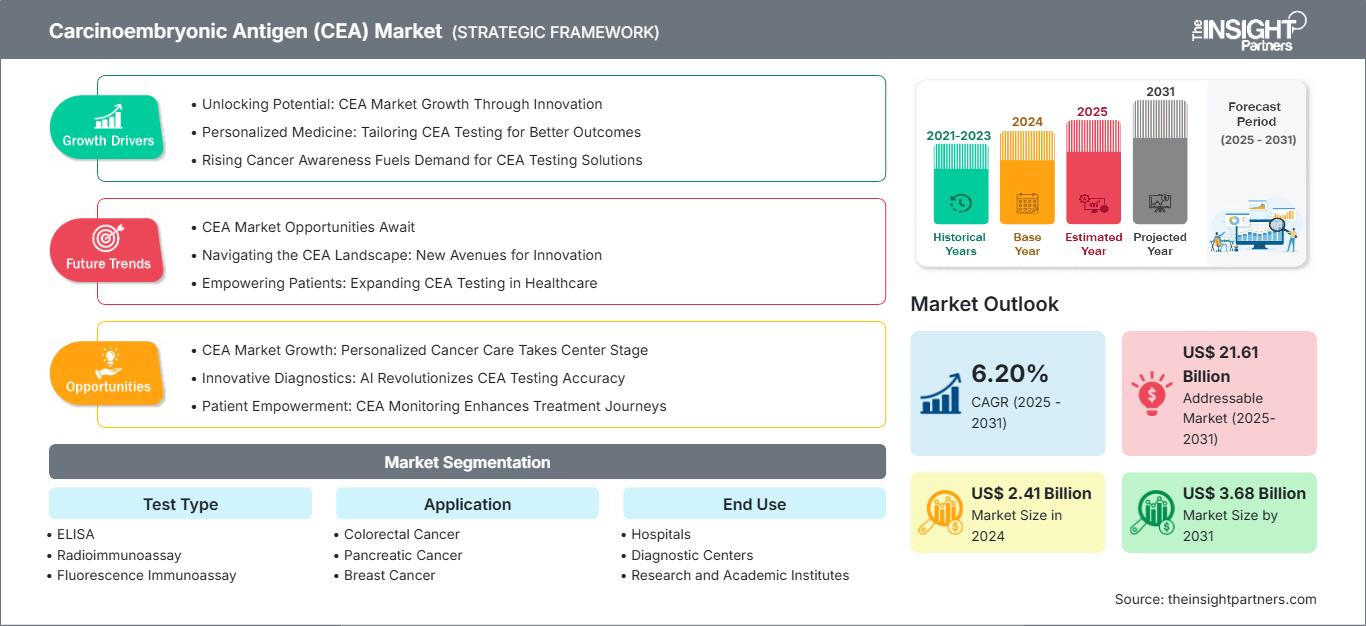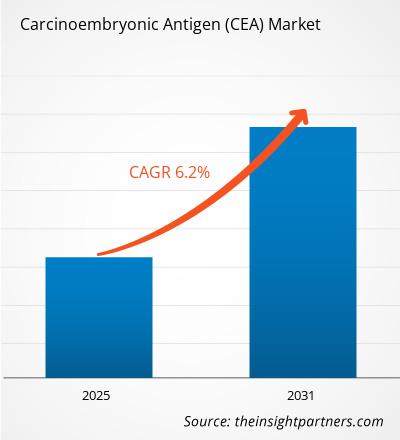Si prevede che il mercato dell'antigene carcinoembrionario (CEA) registrerà un CAGR del 6,20% dal 2025 al 2031, con una dimensione del mercato in espansione da 2,41 miliardi di dollari nel 2024 a 3,68 miliardi di dollari entro il 2031.
Il rapporto è suddiviso in base al tipo di test (ELISA, radioimmunoassay, immunoassay a fluorescenza) e analizza ulteriormente il mercato in base all'applicazione (cancro del colon-retto, cancro al pancreas, cancro al seno, cancro ai polmoni). Esamina inoltre il mercato in base all'uso finale (ospedali, centri diagnostici, istituti di ricerca e accademici). Per ciascuno di questi segmenti chiave viene fornita una ripartizione completa a livello globale, regionale e nazionale.
Il rapporto include dimensioni e previsioni di mercato per tutti i segmenti, presentando i valori in USD. Fornisce inoltre statistiche chiave sullo stato attuale del mercato dei principali attori, insieme ad approfondimenti sulle tendenze di mercato prevalenti e sulle opportunità emergenti.
Scopo del rapporto
Il rapporto "Carcinoembryonic Antigen (CEA) Market" di The Insight Partners mira a descrivere il panorama attuale e la crescita futura, i principali fattori trainanti, le sfide e le opportunità. Questo fornirà spunti di riflessione a diversi stakeholder aziendali, tra cui:
- Fornitori/produttori di tecnologia: per comprendere le dinamiche di mercato in evoluzione e conoscere le potenziali opportunità di crescita, consentendo loro di prendere decisioni strategiche informate.
- Investitori: per condurre un'analisi completa delle tendenze in merito al tasso di crescita del mercato, alle proiezioni finanziarie del mercato e alle opportunità esistenti lungo la catena del valore.
- Enti di regolamentazione: regolamentano le politiche e le attività di controllo sul mercato con l'obiettivo di ridurre al minimo gli abusi, preservare la fiducia degli investitori e sostenere l'integrità e la stabilità del mercato.
Segmentazione del mercato dell'antigene carcinoembrionario (CEA)
Tipo di test
- ELISA
- Radioimmunoanalisi
- Immunoassay a fluorescenza
Applicazione
- cancro colorettale
- Tumore del pancreas
- Tumore al seno
- cancro ai polmoni
Uso finale
- Ospedali
- Centri diagnostici
- Istituti di ricerca e accademici
Riceverai la personalizzazione gratuita di qualsiasi report, incluse parti di questo report, analisi a livello nazionale, pacchetto dati Excel e potrai usufruire di fantastiche offerte e sconti per start-up e università.
Mercato dell'antigene carcinoembrionario (CEA): approfondimenti strategici

-
Scopri le principali tendenze di mercato di questo rapporto.Questo campione GRATUITO includerà analisi dei dati, che spaziano dalle tendenze di mercato alle stime e alle previsioni.
Fattori di crescita del mercato dell'antigene carcinoembrionario (CEA)
- Sbloccare il potenziale: crescita del mercato CEA attraverso l'innovazione
- Medicina personalizzata: adattare i test CEA per ottenere risultati migliori
- La crescente consapevolezza sul cancro alimenta la domanda di soluzioni per i test CEA
Tendenze future del mercato dell'antigene carcinoembrionario (CEA)
- Le opportunità di mercato CEA attendono
- Orientarsi nel panorama CEA: nuove strade per l'innovazione
- Dare potere ai pazienti: estendere i test CEA nell'assistenza sanitaria
Opportunità di mercato dell'antigene carcinoembrionario (CEA)
- Crescita del mercato CEA: l'assistenza personalizzata contro il cancro è al centro della scena
- Diagnostica innovativa: l'intelligenza artificiale rivoluziona l'accuratezza dei test CEA
- Responsabilizzazione del paziente: il monitoraggio CEA migliora i percorsi di trattamento
Approfondimenti regionali sul mercato dell'antigene carcinoembrionario (CEA)
Le tendenze regionali e i fattori che influenzano il mercato dell'antigene carcinoembrionario (CEA) durante il periodo di previsione sono stati ampiamente spiegati dagli analisti di The Insight Partners. Questa sezione illustra anche i segmenti e la distribuzione geografica del mercato dell'antigene carcinoembrionario (CEA) in Nord America, Europa, Asia-Pacifico, Medio Oriente e Africa, America Meridionale e Centrale.
Ambito del rapporto di mercato dell’antigene carcinoembrionale (CEA).
| Attributo del report | Dettagli |
|---|---|
| Dimensioni del mercato nel 2024 | 2,41 miliardi di dollari USA |
| Dimensioni del mercato entro il 2031 | 3,68 miliardi di dollari USA |
| CAGR globale (2025 - 2031) | 6,20% |
| Dati storici | 2021-2023 |
| Periodo di previsione | 2025-2031 |
| Segmenti coperti |
Per tipo di test
|
| Regioni e paesi coperti |
America del Nord
|
| Leader di mercato e profili aziendali chiave |
|
Densità degli attori del mercato dell'antigene carcinoembrionario (CEA): comprendere il suo impatto sulle dinamiche aziendali
Il mercato dell'antigene carcinoembrionario (CEA) è in rapida crescita, trainato dalla crescente domanda da parte degli utenti finali, dovuta a fattori quali l'evoluzione delle preferenze dei consumatori, i progressi tecnologici e una maggiore consapevolezza dei benefici del prodotto. Con l'aumento della domanda, le aziende stanno ampliando la propria offerta, innovando per soddisfare le esigenze dei consumatori e sfruttando le tendenze emergenti, alimentando ulteriormente la crescita del mercato.

- Ottieni una panoramica dei principali attori del mercato dell'antigene carcinoembrionario (CEA)
Punti di forza chiave
- Copertura completa: il rapporto copre in modo completo l'analisi di prodotti, servizi, tipologie e utenti finali del mercato dell'antigene carcinoembrionario (CEA), fornendo un panorama olistico.
- Analisi degli esperti: il rapporto è redatto sulla base della conoscenza approfondita di esperti e analisti del settore.
- Informazioni aggiornate: il rapporto garantisce la pertinenza aziendale grazie alla copertura delle informazioni più recenti e delle tendenze dei dati.
- Opzioni di personalizzazione: questo report può essere personalizzato per soddisfare le esigenze specifiche del cliente e adattarsi in modo appropriato alle strategie aziendali.
Il rapporto di ricerca sul mercato dell'antigene carcinoembrionario (CEA) può quindi contribuire a tracciare un percorso di decodificazione e comprensione dello scenario del settore e delle prospettive di crescita. Sebbene possano esserci alcune valide preoccupazioni, i vantaggi complessivi di questo rapporto tendono a superare gli svantaggi.
- Analisi storica (2 anni), anno base, previsione (7 anni) con CAGR
- Analisi PEST e SWOT
- Valore/volume delle dimensioni del mercato - Globale, Regionale, Nazionale
- Industria e panorama competitivo
- Set di dati Excel
Report recenti
Testimonianze
Motivo dell'acquisto
- Processo decisionale informato
- Comprensione delle dinamiche di mercato
- Analisi competitiva
- Analisi dei clienti
- Previsioni di mercato
- Mitigazione del rischio
- Pianificazione strategica
- Giustificazione degli investimenti
- Identificazione dei mercati emergenti
- Miglioramento delle strategie di marketing
- Aumento dell'efficienza operativa
- Allineamento alle tendenze normative






















 Ottieni un campione gratuito per - Mercato dell’antigene carcinoembrionale (CEA).
Ottieni un campione gratuito per - Mercato dell’antigene carcinoembrionale (CEA).